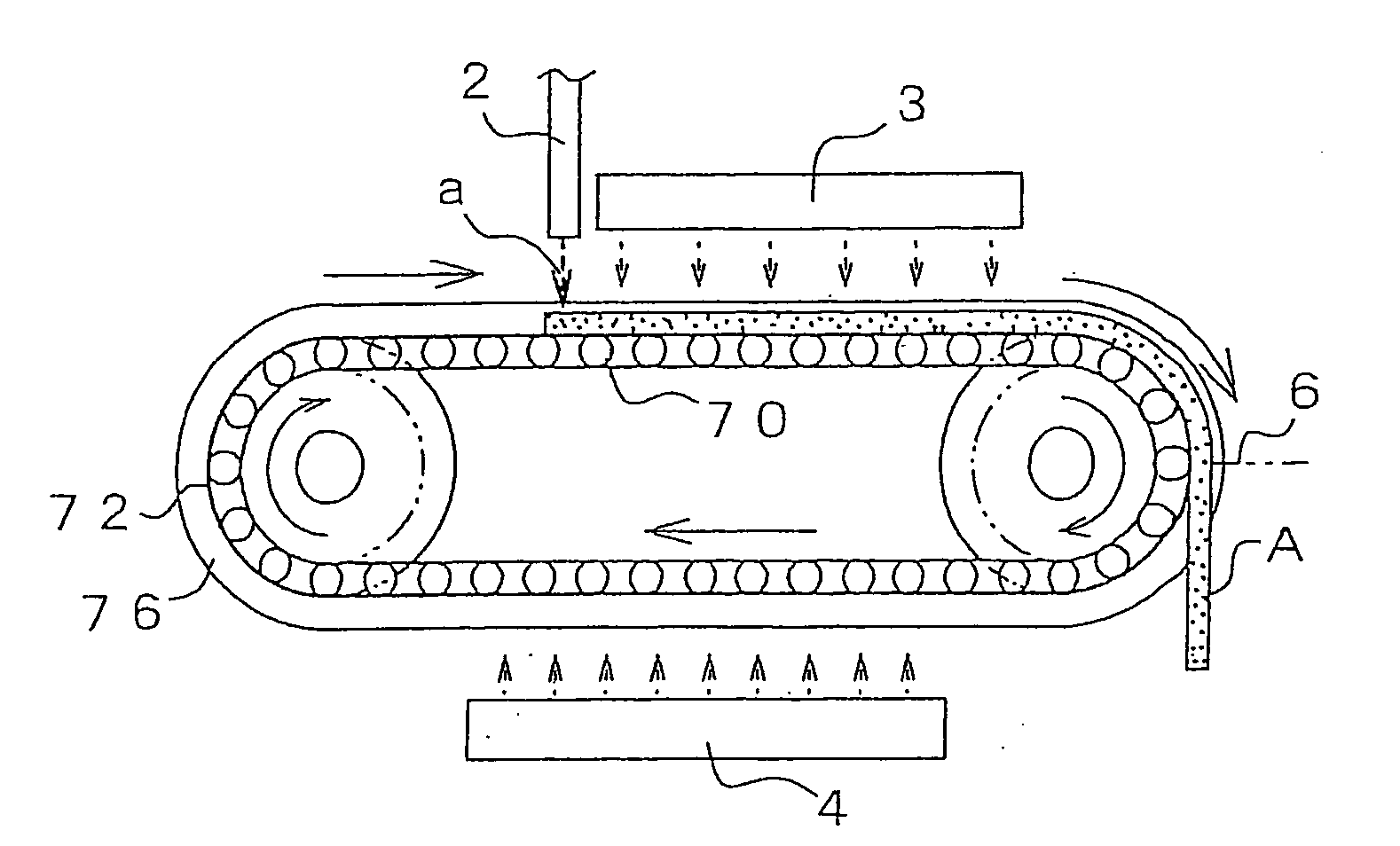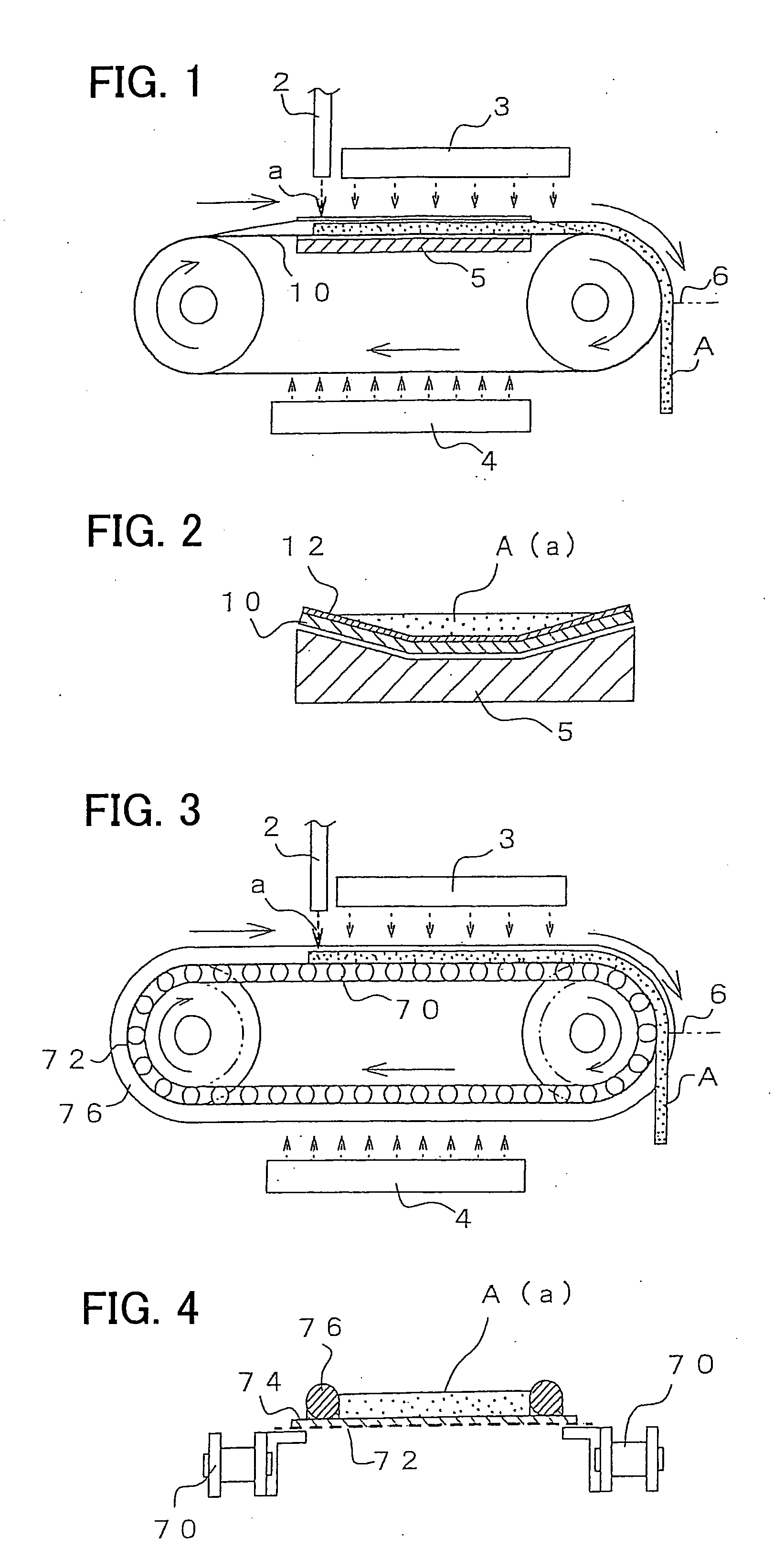Production method of water-absorbent resin
a water-absorbing resin and production method technology, applied in chemical/physical/physical-chemical stationary reactors, chemical apparatus and processes, chemical/physical/physical-chemical processes, etc., can solve the problems of difficult to completely melt and fluidize ptfe, and it is impossible to mold a flat surface, so as to reduce the remaining monomer, promote the decomposition of each polymerization, and reduce the effect of the remaining monomer
- Summary
- Abstract
- Description
- Claims
- Application Information
AI Technical Summary
Benefits of technology
Problems solved by technology
Method used
Image
Examples
example 1
[0067] A water-absorbent resin was produced by using a continuous polymerization device (1) provided with an endless belt conveyor illustrated in each of FIG. 1 and FIG. 2.
[0068] In the device (1), an endless strip-shaped belt 10 was driven by rollers disposed on both ends so as to move in a loop shape. Thus, in a moving loop, an upper portion and a lower portion of the belt 10 horizontally moved in directions opposite to each other.
[0069] The belt 10 was entirely made of glass fiber base material, and a fluororesin layer 12 was laminated on a surface of the belt 10. The fluororesin layer 12 was a film molded by carrying out melt extrusion with respect to tetrafluoroethylene / perfluoroalkylvinylether copolymer (PFA) whose melt viscosity was 5×103 poise at 380° C. so as to have thickness of 100 μm. The surface roughness of the film 12, that is, the surface roughness being in contact with monomer liquid a was Rz 0.35 μm.
[0070] Above the moving loop of the belt 10, a monomer supplyin...
example 2
[0080] A continuous polymerization device (2) provided with an endless chain conveyor illustrated in each of FIG. 3 and FIG. 4 was used to produce a water-absorbent resin. An arrangement thereof was basically the same as the continuous polymerization device of Example 1, so that differences therebetween will be mainly explained.
[0081] As detailed in FIG. 4, a pair of chains 70 respectively positioned left and right were connected with each other by a stainless gauze 72 (Φ1 mm, 8 mesh). On the gauze 72, a fluororesin sheet (PFA sheet) 74 is placed and fixed. The fluororesin sheet 74 was molded by carrying out melt extrusion with respect to a tetrafluoroethylene / perfluoroalkylvinylether copolymer (PFA) whose melt viscosity at 380° C. was 5×103 poise, and its width was 70 cm and its thickness was 250 μm. The surface roughness of the PFA sheet, that is, the roughness of the surface being in contact with the monomer liquid a was Rz 0.25 μm.
[0082] Further, on the fluororesin sheet 74, a...
example 3
[0091] A water-absorbent resin was produced in the same manner as in Example 2 by using a continuous polymerization device (2′) similar to the continuous polymerization device (2) except that: the sheet 74 (PFA sheet) of the continuous polymerization device (2) used in Example 2 was replaced by a sheet (FEP sheet) molded by carrying out melt extrusion with respect to tetrafluoroethylene / hexafluoropropylene copolymer (FEP) whose melt viscosity was 8×103 poise at 380° C. so as to have width of 70 cm and thickness of 500 μm (the surface roughness of the FEP sheet, that is, the surface roughness being in contact with monomer liquid a was Rz 0.30 μm).
[0092] Specifically, a strip-shaped hydrogel was generated in the same manner as in Example 2, and the thus generated strip-shaped hydrogel was continuously detached from the sheet. This continuous production was carried out for 50 hours. Then, it was proved that no hydrogel adhered to the sheet after 50-hour operation. The hydrogel obtaine...
PUM
| Property | Measurement | Unit |
|---|---|---|
| Temperature | aaaaa | aaaaa |
| Temperature | aaaaa | aaaaa |
| Angle | aaaaa | aaaaa |
Abstract
Description
Claims
Application Information
 Login to View More
Login to View More - R&D
- Intellectual Property
- Life Sciences
- Materials
- Tech Scout
- Unparalleled Data Quality
- Higher Quality Content
- 60% Fewer Hallucinations
Browse by: Latest US Patents, China's latest patents, Technical Efficacy Thesaurus, Application Domain, Technology Topic, Popular Technical Reports.
© 2025 PatSnap. All rights reserved.Legal|Privacy policy|Modern Slavery Act Transparency Statement|Sitemap|About US| Contact US: help@patsnap.com


